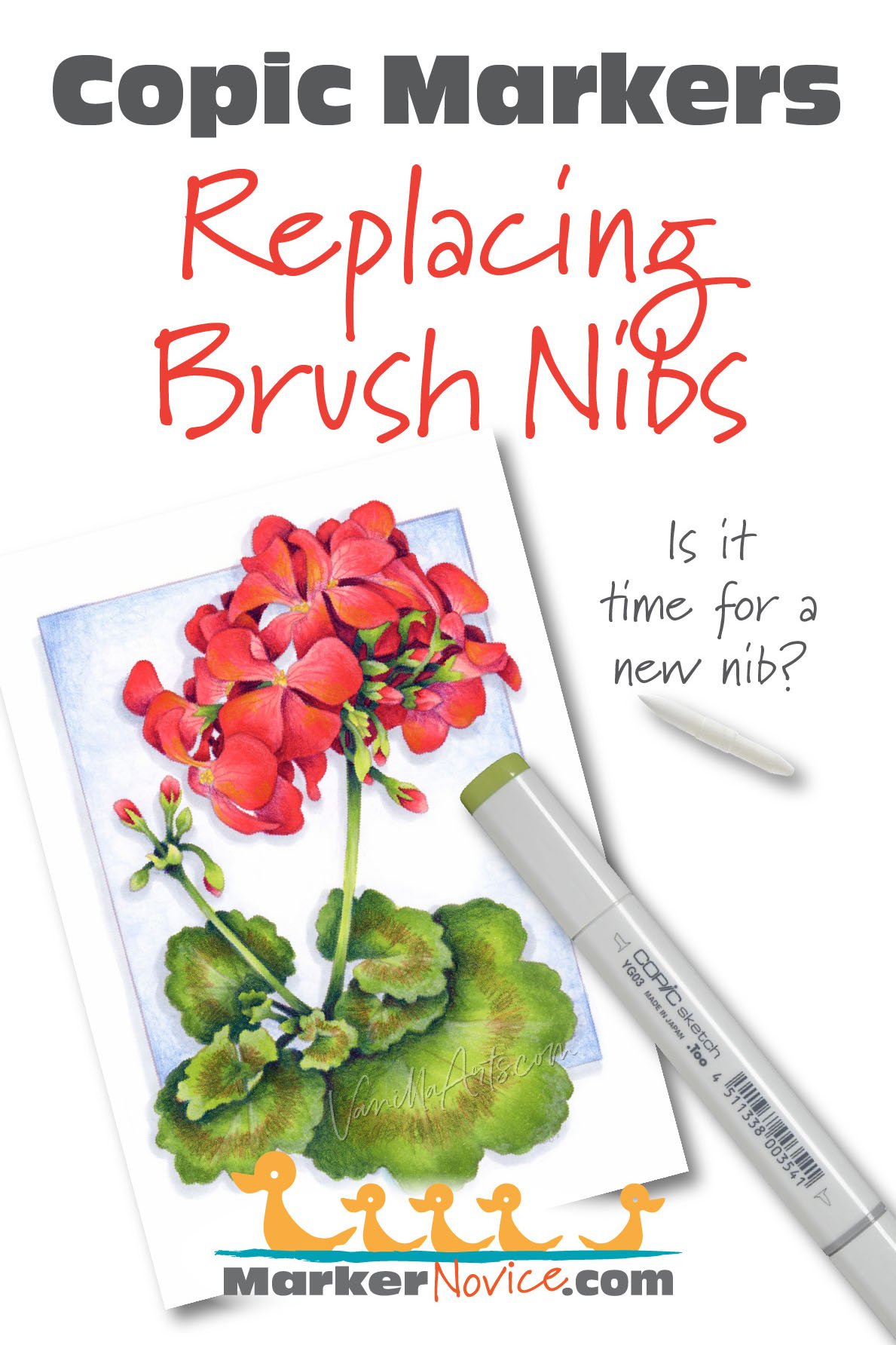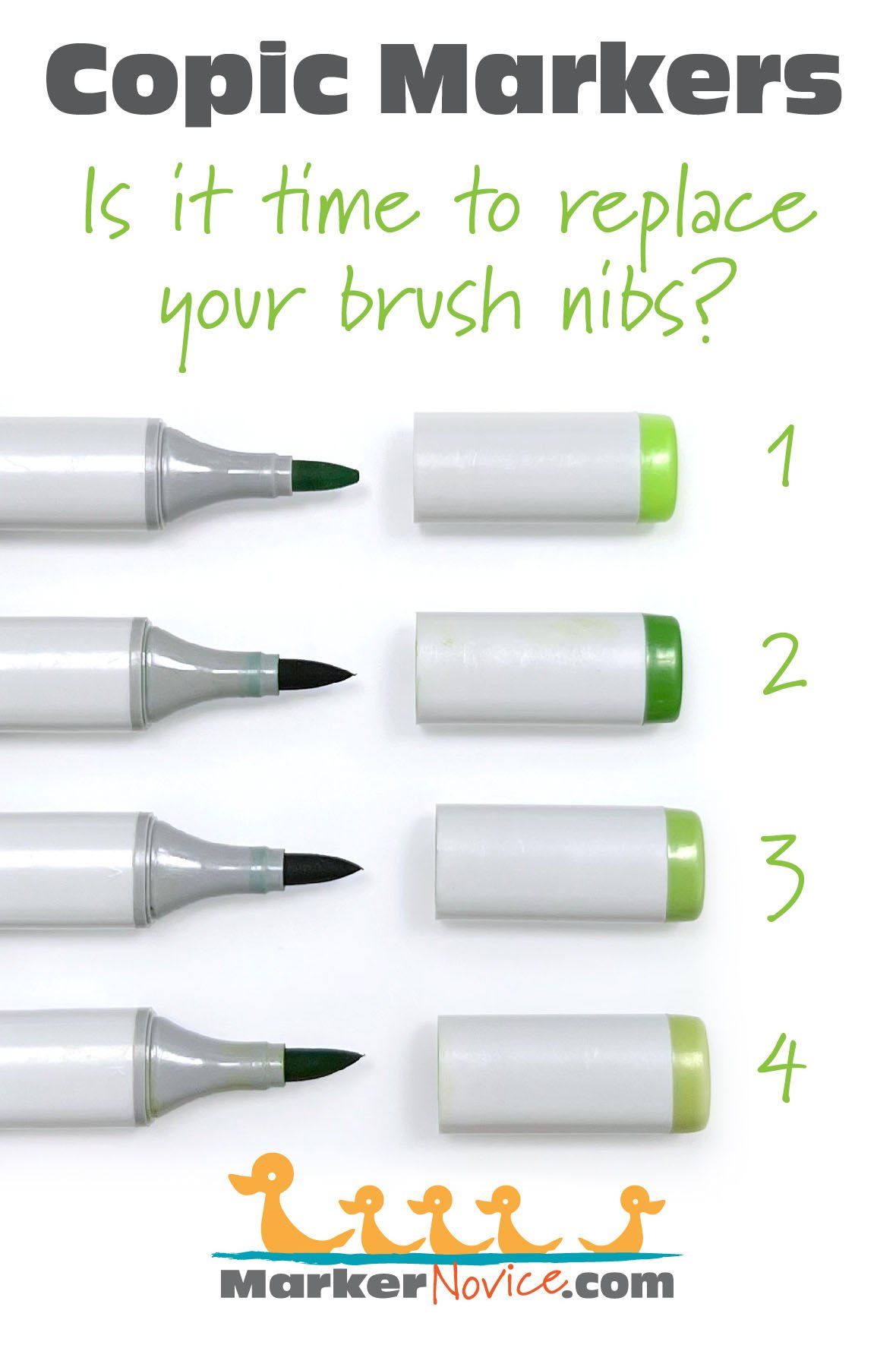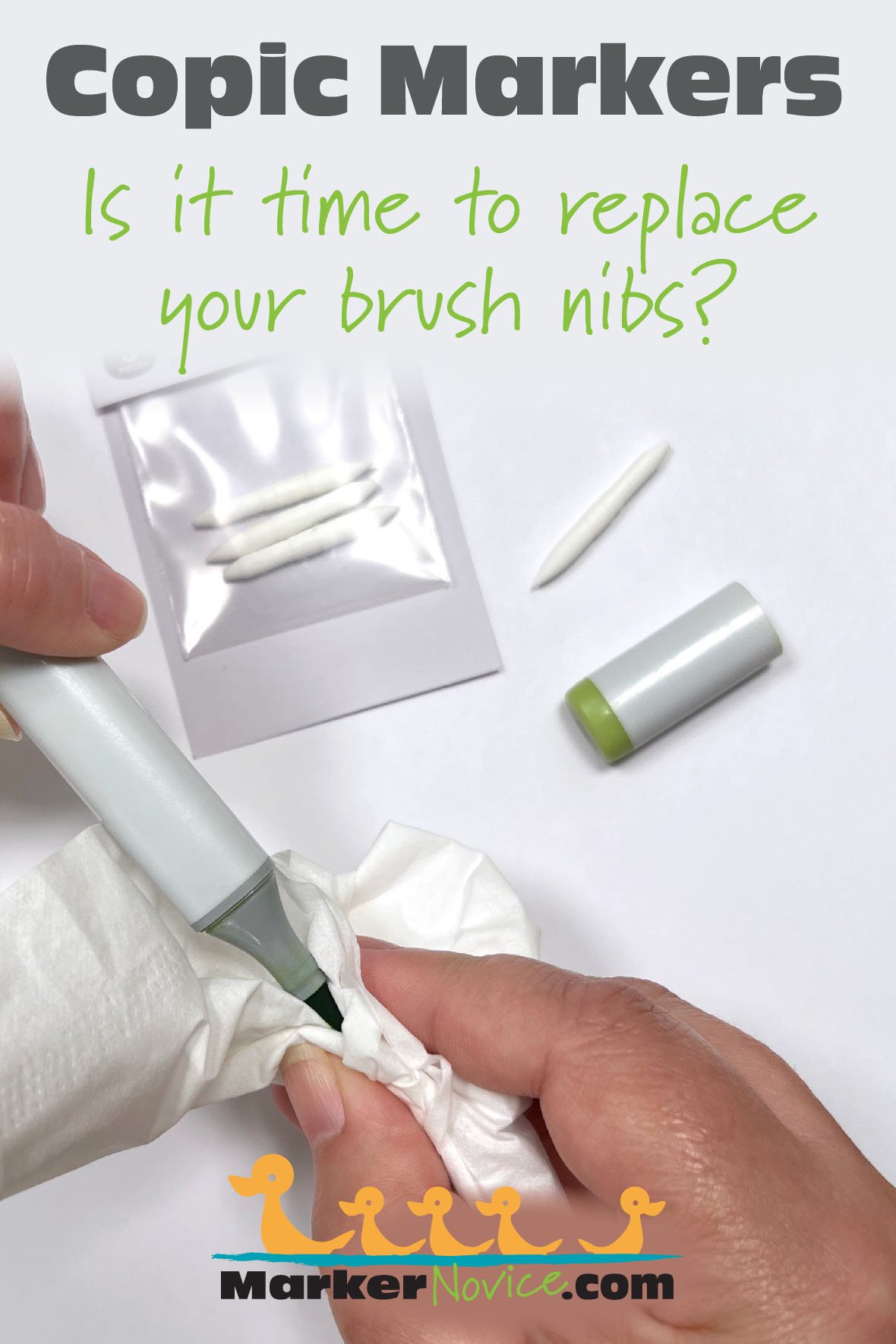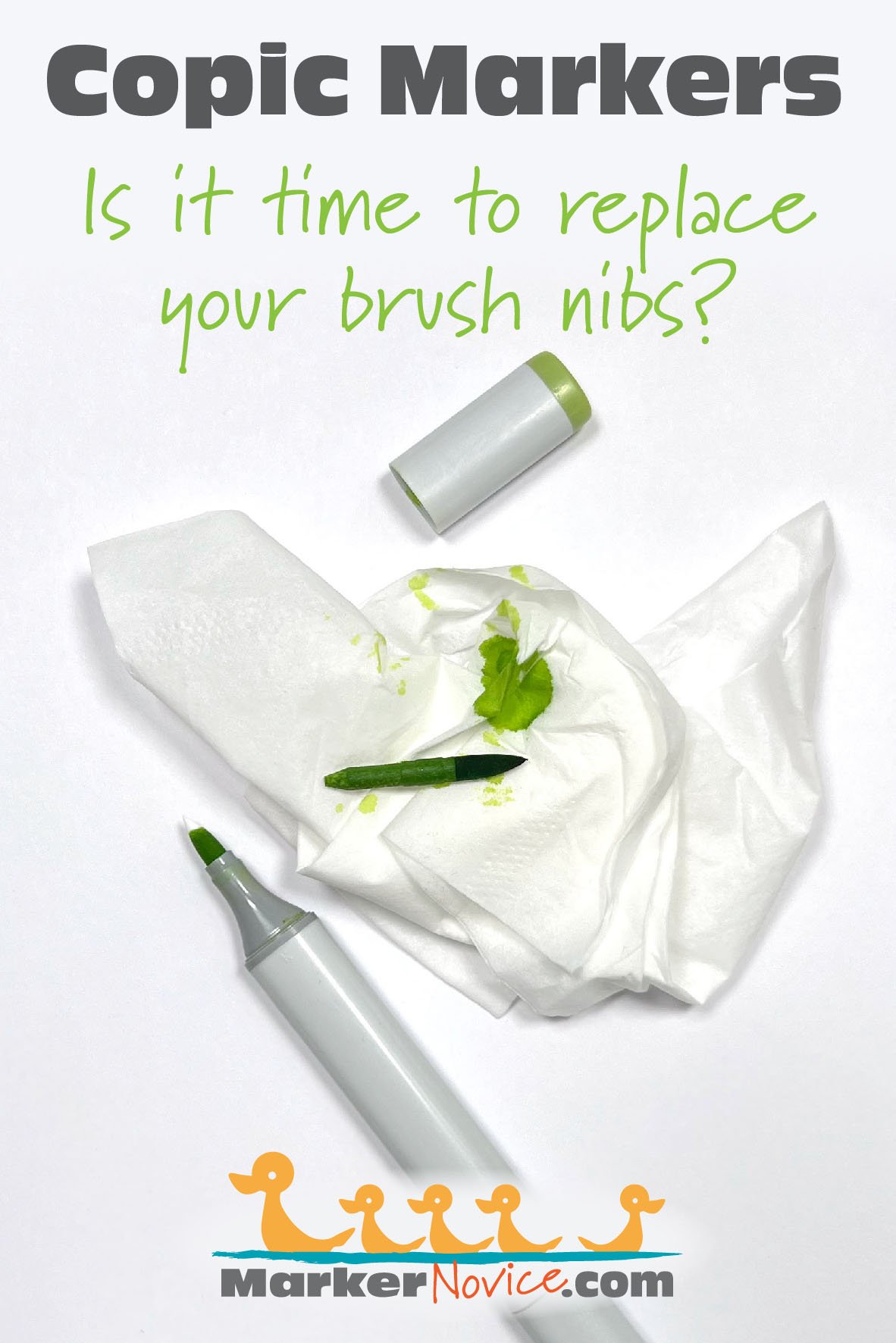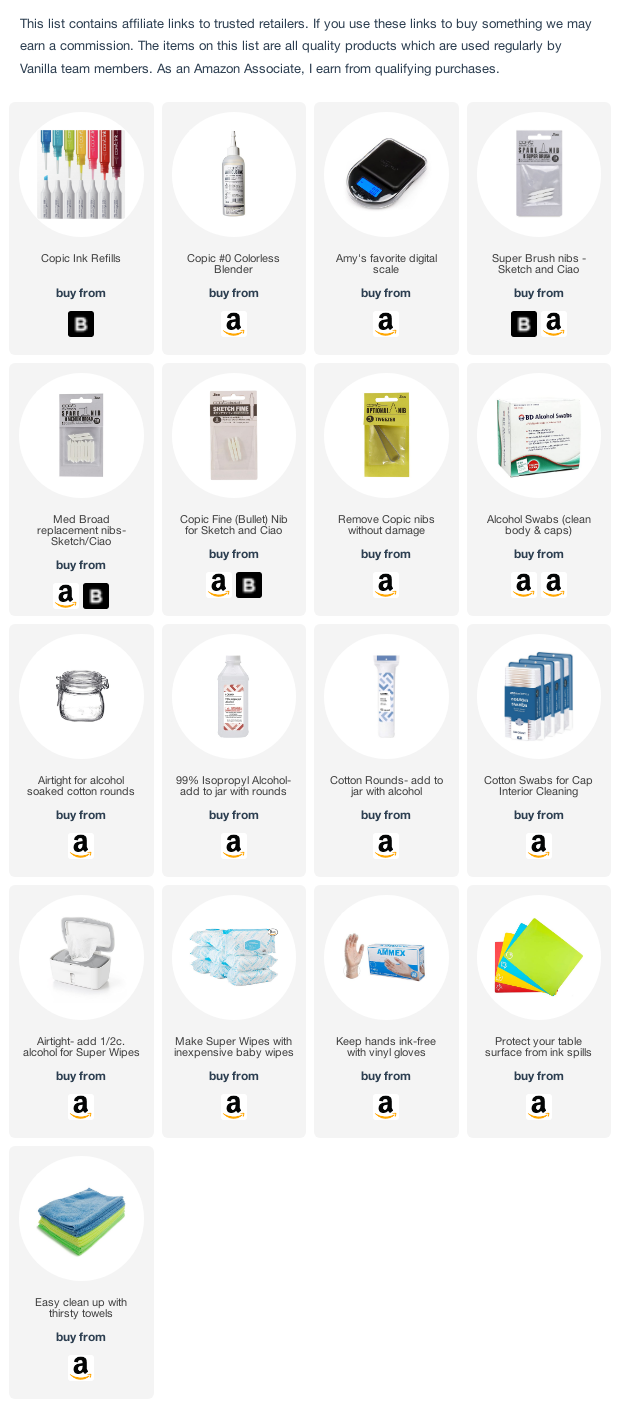I purchased my first art markers in 1989 for a Marker Illustration class in art school. Back then, markers only had chisel nibs and when we damaged a nib, we threw the marker away, even if it wasn’t empty!
When Copic developed replaceable nibs, artists were thrilled. We could stop trashing otherwise-good markers.
Today, we love Copic Markers because of their replace & refill system. With proper care, Copics can last decades. I’m still using Copics from the 1990’s but I’m not using the original nibs!
As a marker instructor, here’s a frustrating observation:
Many Copic users have NEVER replaced a nib!
Yep, lots of people are coloring with dead marker nibs— floppy, squishy, or leaky brush nibs which actually make coloring harder!
Odds are, you’re one of them.
Today, let me show you how simple it is to install a fresh nib to instantly improve the look of your coloring.
Copic Marker Care and Maintenance
Copic Markers feature replaceable nibs because nibs do not last forever. For accurate coloring and easy blending, replace brush nibs when they show wear to insure juicy, springy, pointed nibs. In this article, we provide photos of worn nibs and offer tips plus the easy steps to install new Copic brush nibs.
Note: this article contains affiliate links to products mentioned. We only link to products we endorse and we source them to retailers we use and trust.
Why is it Important To Replace Copic Marker Nibs?
Thirty-some years ago when Copics were rare in the US, they were prized by designers, artists, and illustrators. No artist wants to fight with their supplies, so when we damage a nib, we swap it fast.
Artists know, the quality of our art suffers when we use broken supplies.
“Scarlet Geranium” by the author, Amy Shulke. Copic Markers and Prismacolor Premier Colored Pencils on X-Press It Blending Card. Take the online artistic coloring class which introduces color kissing technique for dynamic color. More info here.
But the modern Copic user is now more likely to be a student, a hobby colorer, or a paper crafter— people on tight budgets or who’d rather spend money on other craft supplies.
When you combine artistic inexperience with frugality, you get a population who don’t recognize the signs of a dying marker or who talk themselves out of normal marker maintenance.
Unfortunately…
Your coloring is only as good as your marker nibs.
When you open a Copic cap to find a crusty nib, you don’t have a choice, you must replace it.
But there are a lot of colorers who try to stretch their nibs past the replacement point. This is when the bad nib starts to make you look like a sloppy or incompetent colorer.
Brush nibs do not get better with age. No brush nib performs as well as it does the first time.
This is because paper is hard and nibs are soft.
Look, you don’t think twice about sharpening a pencil. Pencil leads wear down and lose their point because paper is abrasive.
Like pencil leads, a soft felt fiber brush nib is also no match for abrasive paper tooth.
Even if the paper feels smooth to your fingers, it’s still rough on your marker nibs. Paper acts like sandpaper, rounding-off the point of the nib. It also pulls fibers away from the felt causing the nib to gradually grow fuzzy over time.
Because we can’t sharpen a marker nib, you must replace it.
Marker nibs don’t just go dull and fuzzy, they also go limp.
With normal use, we press the marker nib into the paper to release ink. We physically bend the brush nib every time we color.
A new marker nib snaps back after it’s bent. But with every bend, it gets a little less snappy. Artists call this snap-back “spring” and markers lose spring much faster than paintbrushes.
Dull, fuzzy, or floppy nibs are difficult to control.
It really is the difference between a 21 year old Olympic athlete and your 79 year old grandpa with a cane.
Dull, rounded brush nibs do not place ink on the paper where you expect
They’re slow to respond to commands
They spread ink inconsistently with random surges and dry spells
Remember, forty years ago, we used to throw away a marker that misbehaved.
Now we’ve got a whole generation of Copic fans who are reluctant to change bad nibs.
And your coloring looks worse for it.
When To Replace a Copic Brush Nib
Keep in mind that we tend not to notice subtle changes over time. You grow accustomed to the feel of less spring in your brush nib and you won’t always notice the growing fuzz on a nib if you use it frequently.
When you uncap a Copic for the first time in a while, take a moment to evaluate the health of your brush nib.
I can’t tell you how often I catch dull nibs this way. “Dang, that’s really rounded! How did I not notice it last time?”
But before we discuss the signs of a dead or dying brush nib, it’s important to note:
Copic Brush Nibs are made out of two kinds of felt. Felt is not a woven fabric. Instead, felt is a dense tangle of fibers, bunched tightly together.
The center core of a Copic brush nib is hardened felt. It provides stability and spring.
The hard core wears a triangular “party hat” of softer felt. This soft cap is the ink applicator, the only part that makes contact with the paper.
When is it time to replace a brush nib?
Here’s what to look for:
1. Rounded End: Paper tooth slowly wears away the point of the nib. Dull nibs cause accuracy issues because it’s hard to predict exactly where you’re contacting the paper with a rounded nib. You’ll see more coloring outside the lines and fewer sharp corners or crisp details from blunt nibs. They’re also unexpectedly juicy because there’s less felt to hold-back the ink coming from the marker. Rounded nibs are disasters waiting to happen. Change them immediately.
2. Stray Hairs: Before a nib becomes rounded, you’ll often see loose hairs hanging out from the point of the nib. These are fibers which have been pulled loose from the soft felt. Stray hairs can make unwanted marks as you color— it’s like a mini-marker with a mind of its own. One hair is usually the start of many more, as the felt fibers gradually untangle themselves. Instead of fighting the hair, just change the nib.
3. End Ball: These are related to stray hairs but worse. Instead of a few fibers, this is an entire clump separating from the soft felt hat. While a stray hair leaves little ink lines, a ball leaves darker squiggles and bumps. I’ve even had bumps fall off as I color, they lay on the paper making a dark spot. If you try to brush the ball away, they leave drag marks. I can deal with a hair but a ball is a no-go! Change the nib or you will regret it.
4. Bent Nib: See how this nib is flat on one side? It has lost the ability to spring back after bending. Basically, the hard-felt core in the center of the nib has started to go soft. This is a slight bend but I’ve seen students using far worse! I’ve seen nibs noticeably pointing in odd directions and I’ve seen (many!) students dragging floppy nibs across the paper like a wet rag mop. Change the nib immediately because this nib makes your coloring look sloppy.
The most important factor: FEEL
As you gain Copic experience, the markers become a natural extension of your hand. You’ll start to feel the nib as it glides across smooth or toothy paper.
Nib awareness is the first thing to tell me it’s time to change my nib.
New nibs feel springy and slick as I color. Old nibs feel spongy and they stutter across the surface. There’s also a slight response delay with old nibs, they resist turning and are slow to follow commands.
A good artist doesn’t waste time fighting their art supplies.
Change the nib when it feels wrong.
Not Shown Here: DEAD SPOTS
Dead or dry areas on the nib are another important reason to replace the marker nib, but today, I’m talking about signs of normal use, not marker abuse.
Dead spots are a symptom of Copic abuse.
White or light spots along the side of your brush nib are a sign that you’ve deliberately let your marker run dry by refusing to refill it properly.
You can kill a Copic Marker by failing to refill it regularly.
And I do mean kill. When you let a marker run dry, you allow the core to harden and cure. You can’t fix a cured core. You can’t replace the core, you can’t clean a core, you can’t soak it back to health. The marker is dead.
Because refill neglect is a much larger subject, I’ll link to my related article over on my other website, VanillaArts.com
How Long Do Copic Brush Nibs Last?
“Hey, Amy— I’ve only had my markers for a few months. Do I need new nibs already?”
Marker nibs are not like milk; they don’t have concrete expiration dates.
The longevity of a marker nib is determined by how you use it.
I’ve built a career using Copic Markers daily, so I wear-out nibs faster than someone who only colors on weekends.
The more you color, the sooner you’ll need new nibs.
My burn rate varies by color. My average is about one nib per year for most markers.
But I rarely touch some of my markers— many RVs, Ws, and some Es, can go years before I need a new nib.
Meanwhile B32, B60, BV23, V15, YG03, and YG17 may need 2-3 replacements per year.
But I’m an unusual case. My burn rate doesn’t help estimate yours.
Instead, let’s talk about common behaviors which cause excessive nib wear.
The more of these you do, the sooner you’ll need new nibs:
Do you use the same colors in most projects?
Do you draw with the marker?
Do you use paper not designed for markers? This includes copy paper, office grade cardstock, card maker’s premium cardstock, mixed media paper, any paper with laid or impressed texture, Bristol or illustration board, or watercolor paper.
As you draw or color, do you drive the marker? Driving is where you push the point of the marker as opposed to pulling the point where you want it to go. It’s like when you push the bristles of a paintbrush rather than pulling.
Do you color on the point of the nib more than on the side?
Do you color larger projects (over 8”) or expansive backgrounds?
Do you color with circular strokes?
Do you blend light to dark?
Do you blend using a scrubbing technique?
Okay, so those are all things which cause extra friction-wear on the soft felt cover of a brush nib.
Now let’s talk pressure.
Hand pressure shortens the lifespan of a Copic Brush Nib.
Heavy handed coloring where you physically use more force than necessary will kill a brush nib faster than friction. You’re not only wearing on the nib’s soft felt cover but you’re also breaking the hard felt core.
And this is where Copic beginners and once-in-a-while colorers lull themselves into a false sense of security.
Many beginners think “my markers are new”. Infrequent colors think “I only color once a month”. Both are trying to delay the inevitable purchase of replacement nibs.
The problem is, inexperience leads to greater nib damage.
Beginners and those with poor technique damage nibs faster than other colorers because they haven’t learned how to control hand pressure.
So there’s actually a similarity between my burn rate and the burn rate of a heavy handed novice using poor coloring technique.
Intermediate and advanced weekend colorers need fewer nib-changes than beginners and pros.
Weird but true.
Important Tip: Purchase Copic Nibs By the Dozen
When you shop for replacement brush nibs, I recommend buying several packs at once.
Buying in quantity may get you a nice discount but that’s not why. When you only have 3 extra nibs, it changes how you evaluate a worn nib.
Scarcity creates stupidity.
If you only have a couple replacement nibs, you’ll treat them as precious and you’ll color too long on a dead or dying nib.
On the other hand, if you have lots of extra nibs in a cute little jar by your coloring desk and they’re ready to go at a moment’s notice, you’ll start changing nibs as often as needed with no debate, drama, or angst.
How to Replace a Copic Brush Nib
Okay, let me start by saying— Copic makes a very nice set of serrated tweezers, designed especially for removing Copic nibs.
But if I’m honest, I never use the tweezers. Never.
I can see how they’re handy. Copic brush nibs are a bit fragile. It’s easy to accidentally pull off just the soft felt “party hat” instead of removing the whole nib.
And darn it, once you take off the party hat, it never goes back the right way.
So if you intend to remove a brush nib and then put the same brush nib back? That’s when a dedicated set of specialty tweezers makes sense.
But me? I’m throwing bad nibs in the trash.
Tweezers only slow me down.
How to replace a Copic Brush Nib:
This method works for both Super Brush Nibs and Standard Brush Nibs. Actually, I use this method with chisel nibs too.
To prevent inky fingers, I grab the old brush nib with a wadded-up facial tissue. Don’t squeeze too hard because like a sponge, the nib will leak ink when pressed. Medium firm pressure will do.
Make sure you’re grasping the nib close to the plastic housing. If you pull just the point, you’ll only remove the soft felt “party hat”.
Pull firmly, straight out. If you accidentally remove just the party hat, go back for a second pull. The hard nib-core will not resist if you have a proper hold on it.
With the brush nib fully removed, I take the opportunity to refill my marker via the open end. I refill by weight using the method mentioned in the video and article below.
Look closely at the replacement brush nib. The drawing end is soft to the touch and comes to a perfect point. The insertion end is hard has a flattened point.
Using just your fingers (no tissue) insert the flattened point into the open end of the marker barrel. Push moderately firm until you feel the nib make contact with the stopper inside the marker. This doesn’t require excessive pressure, so don’t bend the nib trying to force it further than it wants to go. The nib will naturally stop when the bottom edge of the party hat is just inside the rim of the dark gray plastic. Pushing it farther with force will damage the entire marker.
Now watch and wait as the nib starts to pull ink from the marker. The righthand photo above shows a new nib, almost full. It takes 30-60 seconds for the ink to completely crawl up to the point. If it takes longer, your marker is either low on ink or the marker has permanent interior damage.
Once the nib is fully saturated with ink (color all the way to the point), it’s ready to be used again.
At this point, I clean the barrel and caps, removing both new ink smears and old crusted ink using the tissue we used earlier. Lightly moisten the tissue with rubbing alcohol. You want it damp but not dripping. Wipe the barrel and neck lightly, then push inside the cap to clean there. Avoid getting rubbing alcohol on the new nib (because rubbing alcohol contains 10-30% water).
Can You Revive a Dead Marker Nib?
Trim it with scissors! Rub it on a rough paper towel! Soak it in colorless blender! Soak it in rubbing alcohol! Dry it under the light of a full moon while reciting this incantation!
Can we not?
Cleaning an old nib is more trouble than it’s worth.
Granted, coloring is my job, so I’d have to clean a lot of nibs. Plus, I go back to the olden days before replacement parts when we routinely threw markers away without a second thought.
Maybe this is why I have a surgeon’s emotional detachment when it comes to tossing Copic brush nibs.
If it’s not working, rip it out!
I do not understand the whole drama about resuscitating damaged nibs.
Maybe if it was the last nib in the world? Then I might be able to justify it.
Maybe.
A replacement nib is under 2 bucks. Most rescue advice involves expensive solvent and several days.
Nope. No thanks.
My time is worth more than that. So is yours.
But here’s the other thing… soaking nibs in alcohol doesn’t work.
Back when I was younger and it took two weeks to receive a Copic order in the mail, I tried soak-cleaning a brush nib.
It was a dark red, possibly R39 or R59. One side of the nib was black and gummy, so I pulled out the nib and popped it into a glass baby food jar filled with laboratory grade Ethyl Alcohol. Lab grade alcohol is like colorless blender on steriods. Being married to an engineer in a chemistry lab has its perks.
I soaked the nib overnight but it didn’t come clean. I scraped away some of the gunk with my fingernail and popped it back in with fresh alcohol. Each day, I de-gunked and freshened the old ethyl until finally, the replacement nibs arrived. At that point, I forgot about the old nib and it got shelved with a bunch of acrylic inks.
THREE YEARS LATER, I found the baby food jar full of red ethyl and inside, the nib still had gooey gunk on it.
This is why I roll my eyes when folks talk about squishing a crusty nib in a ziplock bag with a couple tablespoons of rubbing alcohol.
It sounds like it’d work but my experience says otherwise.
It’s a waste of time and supplies.
Plus, soaking doesn’t fix the wear and tear from friction and pressure.
Just get a new nib. Your time is better spent coloring.
So there you go…
How and When to Replace Worn & Dull Brush Nibs
Copic nibs do not last forever.
Replace brush nibs when they show wear, stray hairs, bends, or off-color spots.
This will insure you always have a juicy, springy, pointed nib.
New nibs make your coloring look better, they also improve your blends and make it easier to stay inside the lines.
Your coloring is only as good as your nibs
So always keep your markers full and in good condition, ready to support your best coloring ever!
By the way…
This article talked about Copic brush nibs but the information also mostly applies to chisel style Broad or Medium nibs. Fewer people use their chisel ends much, but chisels still get fuzzy and wear down.
Amy Shulke is a professional illustrator who has used Copic Markers since 1990. She teaches artistic coloring classes online at VanillaArts.com and locally in south-eastern Michigan.
Marker Novice is Amy’s completely free resource devoted to beginner marker education. For intermediate/advanced artistic coloring articles, see her Studio Journal here.
Further reading on related topics:
(click the pic to read article)
Summer’s Kiss
Are you ready to add artistry to average coloring
Introduction to Color Kissing
You’ve been blending with light, medium, and dark blending combinations, which were fun at first but now they make you yawn. Is this all there is to coloring?
Heck, no! Join Amy for an eye-opening less which will change how you color— adding artistry and amazing pops of unexpected color.
Amy Shulke’s "Scarlet Geranium"
Scarlet Geranium is an intermediate level coloring classes. Basic blending techniques are not covered.
Class package includes full video desmonstration plus digital stamps in several formats. Easy print PDF guides include recipe, full color sample, photo reference, and grayscale guide.

